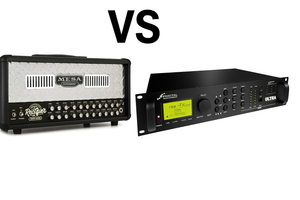Amp Modelers vs. Tube Amps: Is the Future Digital or Still Glowing?
The world of guitar gear has never been more exciting—or more divisive. At the center of one of the hottest debates in modern guitar circles: amp modelers vs. traditional tube amps. Whether you're a bedroom player, gigging musician, or studio junkie, you've probably heard names like Kemper, Fractal Audio (Axe-Fx), or Line 6 Helix thrown around as the future of guitar tone.
But are digital modelers really better than old-school tube amps? Are tube amps becoming dinosaurs in a world of digital convenience? Let’s break it down.
What Are Amp Modelers?
Amp modelers are basically high-tech tone machines. Devices like the Kemper Profiler, Fractal Axe-Fx III, and Line 6 Helix digitally simulate the sound of real amps, speaker cabinets, and effects pedals. Instead of lugging around five amps and a suitcase of pedals, you get all of it in one box. Some modelers, like Kemper, use profiling (think: audio snapshots of real amps), while others use software modeling to recreate the tone from scratch.
The Case for Tube Amps
Tube amps have been the gold standard for decades—and for good reason.
Pros:
-
Warm, organic tone that reacts to your playing like a living thing.
-
Dynamic feel—the harder you dig in, the more it roars.
-
Simplicity—plug in and go. No menu-diving or firmware updates.
Cons:
-
Heavy and fragile—nobody loves hauling a 50lb combo up stairs.
-
Maintenance required—tubes wear out, need biasing, and can fail mid-gig.
-
Expensive—want multiple tones? You’ll need multiple amps.
Why Amp Modelers Are Taking Over
Modelers have gotten really good. Like scary good. For many players, they’ve reached the point where they’re almost indistinguishable from the real thing—especially in a mix or live situation.
Pros:
-
Insane versatility—hundreds of amp models, cabinets, and effects in one device.
-
Lightweight and portable—fits in a backpack.
-
Silent recording and direct gigging—no mic required.
-
Consistent tone—no matter the volume or room acoustics.
Cons:
-
Learning curve—menus, patches, updates. It can feel more like a computer than a guitar rig.
-
Tone purists may still feel something’s missing—some argue the "feel" isn’t quite the same.
-
Dependent on software and power—if it glitches, you’re stuck.
Are Tube Amps Going Extinct?
Here’s the truth: tube amps aren’t dead, but they are evolving into a niche.
Digital rigs are exploding in popularity. Worship bands, touring pros, and even major recording artists are going digital for the convenience and reliability. According to a 2023 Guitar World article, digital amp and effects sales have surged, while tube amp sales have seen a modest decline.
But there’s still a big audience for tube amps—especially among tone chasers, studio owners, and blues/rock purists. Boutique builders are still thriving, and legends like Fender, Vox, and Marshall aren’t slowing down.
In short: tube amps are becoming more of a “craft” item, while digital gear is becoming the everyday workhorse.
So Which One Should You Use?
It depends on what you value.
-
Love pure, raw tone and simplicity? Tube amps all day.
-
Need versatility, portability, and consistency? Get a modeler.
There’s no right or wrong—just the right tool for your job. And in 2025, it’s never been easier to have both. Some players even run modelers through a tube power amp to get the best of both worlds.
Final Thoughts
Amp modelers are the future, but tube amps aren’t going anywhere. It’s not a war—it’s a toolbox. Whether you’re rocking a vintage Deluxe Reverb or a Helix preset called "Meaty 5150 Clone," what matters most is the music you make with it.
So don’t sweat the gear wars. Try both. Use what inspires you. And crank it—digital or not.

